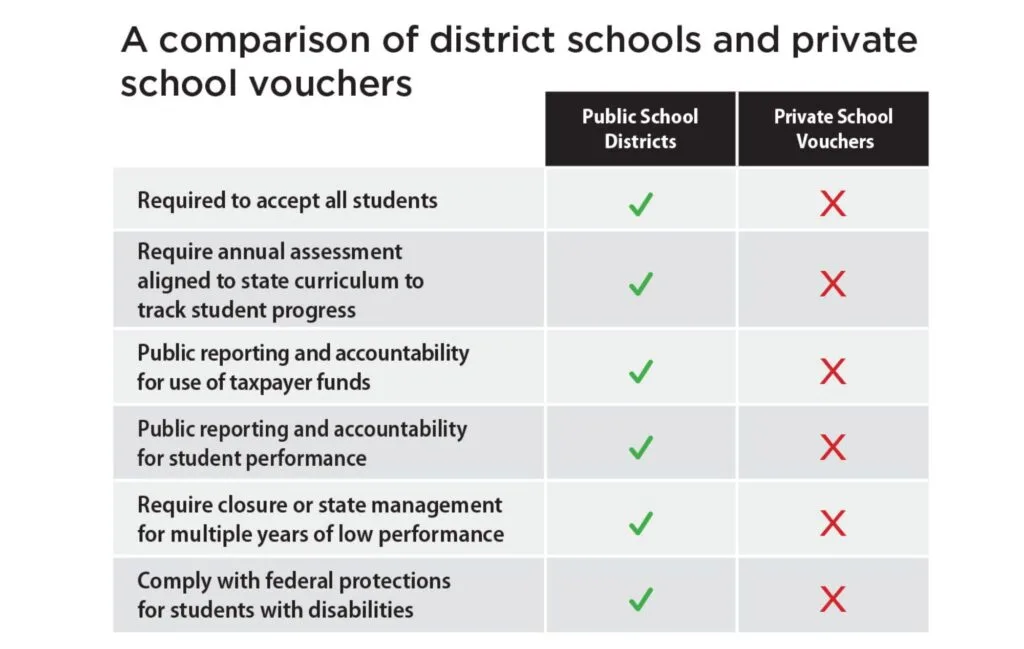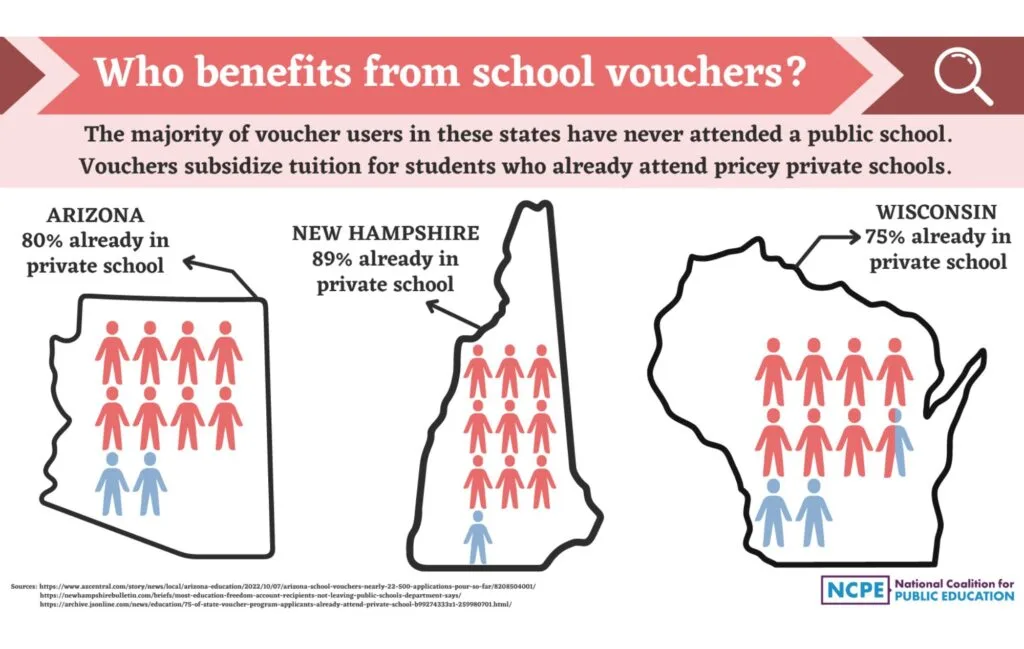In recent years, school vouchers have become a controversial topic in the ongoing debate over educational reform in the United States. Seemingly designed to allow families to choose private or alternative schools for their children over public schools, vouchers are meant to increase competition among schools and improve overall quality.
People who tout the positives of vouchers argue that these programs empower parents to have more choices in where their children go to school, as opposed to being “stuck” with their local public school. However, despite their initial promise, a growing body of evidence suggests that school vouchers fail to deliver the desired outcomes, leading to significant concerns about their effectiveness and equity.
Critics point to a range of issues that voucher programs create, including inadequate funding, enormous misuse of funds, lack of oversight, and unequal access for marginalized communities. Many studies indicate that students who use vouchers often do not perform better academically than their peers in public schools, raising questions about the premise that competition leads to improvement.
Additionally, moving public school funds to private schools exacerbates existing inequalities in the education system, leaving many public schools with an even worse lack of resources. As the debate continues, it becomes crucial to examine not only the intended benefits of school vouchers but also the complex realities that contribute to their shortcomings.
What are school vouchers?
School vouchers are government-funded financial certificates that parents can use to pay for tuition at private or alternative schools instead of enrolling their children in public schools. The idea behind vouchers is to give families more choices in education, allowing them to select schools that they believe will better suit their children’s needs. Tax dollars fund most vouchers, and the amount can vary depending on the program and state.
Arizona was the first
In December 2022, Arizona became the first state to enact a law for school vouchers. The bill, HB 2853, allows all Arizona parents the ability to take state money that would go to their local public school and use it for private school tuition or other educational costs (like homeschooling costs).
The program initially intended to expand educational opportunities outside of public school settings, specifically for students with disabilities. Gradually, however, more categories of students were added. According to the Arizona Department of Education, the vouchers (Empowerment Scholarship Accounts or ESAs) “are funded by state tax dollars, consisting of 90% of state funding that would have otherwise been allocated to the school district or charter school for the qualified student, excluding any federal or local funding.” The amount per student is around $7,000.
The funds can be used for tuition to a private or religious school, textbooks, tutoring services, curriculum, tuition or fees for non-public online learning programs, fees for “nationally standardized achievement tests and grade level testing,” and even uniforms.
Issues in Arizona
The main complaints about ESA vouchers is that they divert tax revenue to subsidize private school tuition. The cost of tuition at most private schools is considerably higher than the value of a voucher. Therefore, wealthy families who can afford the entire balance are the primary beneficiaries of ESA vouchers at the taxpayers’ expense.
Enrollment in the voucher program in Arizona has exploded, with almost 70,000 recipients. Arizona’s schools are already desperately underfunded, and this sort of siphoning of money amounts to about a 20% cut across the board, seriously hurting public schools.
Voucher laws generally do not require private schools to disclose their finances, operations, or measures of student achievement. Arizona’s voucher program is one of the least accountable in the U.S.
Where’s the Money Actually Going?
“Recent audits revealed that private school parents, now voucher recipients, have used the funding for questionable expenses, including kayak lessons, horseback riding lessons, Seaworld tickets, trampolines, home gyms, televisions, and more. Earlier audits conducted before the most recent expansion revealed similarly questionable uses.”
With little to no accountability, the funds are predominantly used by families whose children are already in private schools. Far from saving money as promised in 2022, school vouchers are a “budget-buster.”

Private Schools are the Major Recipients
When the voucher program was first enacted in 2011, it was mainly to help students with disabilities. In 2022, the program was promised to help low-income families have better school choices. It turns out that they take scarce funding from public schools—which serve 90 percent of students—and give it to private schools—institutions that are not accountable to taxpayers.
A 2023 analysis revealed that most universal ESA recipients in Arizona live in areas with median incomes ranging from $81,000 to $178,000. Just 5 percent come from ZIP codes with a median income under $49,000. An earlier report found that 80 percent of voucher applicants did not attend a public school, meaning they were already attending private schools.
The same thing happened in Ohio in 2020, when a voucher law was enacted. “The percentage of participating students who were already enrolled in private school jumped from 7 percent in 2019 to 55 percent in 2023.”
New data from the Iowa Department of Education reveals that two-thirds of students in that state who received a voucher were, again, already enrolled in private school, and only about 13% of recipients had ever previously attended a public school.
The vouchers also pay more than a public school student receives. For example, in Arizona, the per-student allocation is $900 less for public school students than for students whose education is funded through an ESA.
Bankrupting the State
Overall, Arizona’s ESA voucher program is projected to cost $950 million next year, which is $320 million over budget. Illinois recently became the first state to end its voucher program. In November 2023, lawmakers chose not to fund the tax-credit scholarship program, which took $75 million of state money.

Other States with Voucher Laws
In addition to Arizona, Arkansas, Iowa, Montana, Nebraska, Oklahoma, South Carolina, and Utah passed new voucher programs, and 12 states expanded existing programs. Eleven states now have universal voucher laws, and more may be coming in states such as Alabama, Georgia, and Tennessee.
Drop in Test Scores
New evaluations of vouchers in Washington, D.C., Indiana, Louisiana, and Ohio show some of the most significant test score drops ever seen in the research record— “between -0.15 and -0.50 standard deviations of learning loss. That’s on par with what the COVID-19 pandemic did to test scores and larger than Hurricane Katrina’s impacts on academics in New Orleans.”
If private schools are supposed to be the superior choice, why is there a decline in achievement when a voucher is used? “That’s because elite private schools with strong academics and large endowments often decline to participate in voucher plans. Instead, the typical voucher school is a financially distressed, sub-prime private provider often jumping at the chance for a tax bailout to stay open a few extra years.”
In Wisconsin, 41% of voucher schools have closed since the program started in 1990. That includes many “pop-up schools” opening just to cash in on the new voucher pay-out. For those pop-up schools, the average survival time is just four years before their doors close for good.
The turnover of students from voucher schools back to public schools is high. And kids who leave voucher programs tend to be students of color, lower-income children, and kids who were struggling academically in the first place. Then, they return to their seriously underfunded public schools.
Rare Enrollment of Disabled Students
Voucher programs also rarely enroll students with disabilities and can kick a student out at will. Public schools are obligated under federal law to enroll and properly serve special needs children—something private schools can and do avoid.
At first glance, voucher programs might seem like a positive alternative to underfunded, overcrowded, poorly performing public schools. But when you look deeper, they mainly serve wealthy families and siphon much-needed money away from public schools.

